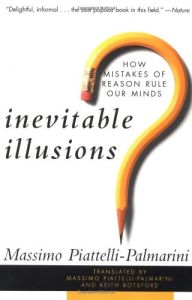Join getAbstract to access the summary!

Join getAbstract to access the summary!
Massimo Piattelli-Palmarini
Inevitable Illusions
How Mistakes of Reason Rule Our Minds
Wiley, 1996
What's inside?
Cognitive illusions play mental tricks on guessers: the next time you trust your intuition, check the math instead.
Recommendation
"Let the thinker beware" could be the motto for this excellent and very useful book. Author Massimo Piattelli-Palmarini has done a masterful job of arraying some of the most serious and most commonplace errors of judgment, estimation and deduction. The style is mostly straightforward, if academic, and makes the meat of the book’s message accessible to the general reader. One quibble is that the author’s explanation of certain probability calculations (especially Bayes’ theorem) leaves them less clear than they could be. That aside, getAbstract.com gives this book the highest recommendation, especially for those who like to consider how people understand their world. If you are devoted to clear thinking, you could practically use it to conduct a daily scrutiny of your mental processes - an examination of cognition similar to the monastic examination of conscience - to identify and correct any inclinations to serious cognitive sin.
Summary
About the Author
Massimo Piattelli-Palmarini is a Principal Research Associate of the Center for Cognitive Science at the Massachusetts Institute of Technology and the Director of the Department of Cognitive Science at the Institute of San Raffaele in Milan, Italy.
















Comment on this summary